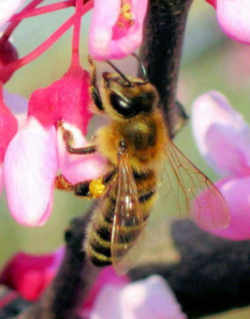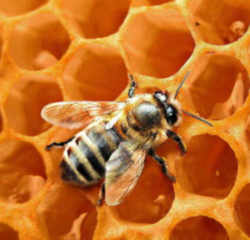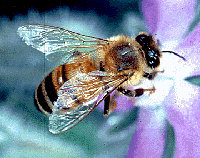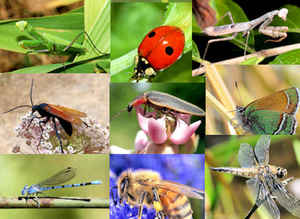
Tennessee Symbols
Tennessee State Agricultural Insect
Honeybee

(Apis mellifera)
Adopted in 1990.
The official state agricultural insect is the honeybee, (Apis mellifera,) and was designated by Public Chapter 725 of the Acts of 1990.The honeybee, Apis mallifera, is a social, honey-producing insect that plays a fundamental role in the production of all crops. It is also very popular for its production of honey and beeswax. Adopted in 1990, the honeybee was the third insect selected by the State of Tennessee to receive an "official" title.
Kenneth Greene, Jr. , beekeeper from Dickson, Tennessee, Greene was involved in an effort to designate the honeybee the United States' national
insect. He contacted then Senator Al Gore, Jr. and asked him for support. But Gore said he would have to favor an insect that was an official state
symbol of Tennessee.
Greene mounted a successful effort to have the honeybee designated Tennessee's official "agricultural insect" in 1992.
Did you know that: The honey bee has been proclaimed the official state insect in each of the following states:
Arkansas | Georgia | Kansas
| Kentucky | Louisiana
Maine | Mississippi |
Missouri | Nebraska | New Jersey
North Carolina | Oklahoma | South
Dakota | Tennessee
Utah | Vermont | West Virginia
| Wisconsin
Tennessee State Agricultural Insect: Honeybee

What's in a Name?
Where Does the Honeybee get her Name?
The honeybee's Latin name, Apis melifera L., stands for "Honey Maker".
The honeybee plays a vital economic role in Tennessee through its pollination of various crops, trees, and grasses. The honeybee is the only insect that can be moved for the express purpose of pollination.
Bees produce honey as food stores for the hive during the long months of winter when flowers aren't blooming and therefore little or no nectar is available to them. European honey bees, genus Apis Mellifera, produce such an abundance of honey, far more than the hive can eat, that humans can harvest the excess. For this reason, European honey bees can be found in beekeeper's hives around the world!
The taste, color and nutrient content of honey varies from place to place depending upon the kind of flora growing in the area. For example, Tupelo honey (from Tennessee) is twice as sweet as most honey. Many people take honey from their own neighborhood as a kind of natural antihistamine.
Sources of Nectar
oney bees forage on many plants for nectar or pollen. All of these sources provide food for the colony. The number of plants that produce large
quantities of surplus nectar for a honey crop are quite limited. Most of the honey produced in the United States is made from nectar that was collected
from about 100 plant species.
In Tennessee, the clovers are the number one source of nectar. White dutch, crimson, white sweet and yellow sweet clovers are some of the surplus nectar
sources. Alfalfa and vetch are related leguminous honey plants.
The tulip-poplar tree is the second largest supplier of nectar for honey production (the bees collect large quantities of nectar from this tree which
blooms in early May).
Sourwood honey is the most popular honey in Tennessee. A large surplus of sourwood honey is produced once every five to seven years in the higher elevations.
In most years, bees store one to two supers of sourwood honey per colony.
Honeybees probably originated in Tropical Africa and spread from South Africa to Northern Europe and East into India and China. They were brought to the Americas with the first colonists and are now distributed world-wide. The first bees appear in the fossil record in deposits dating about 40 million years ago in the Eocene. At about 30 million years before present they appear to have developed social behavior and structurally are virtually identical with modern bees.
Characteristics of Tennessee Honeybee
Colony:
Honey bees are social insects, with a marked division of labor between the various types of bees in the colony. A colony of honey bees includes a queen, drones and workers.
The Queen Bee:
The queen is the only sexually developed female in the hive. She is the largest bee in the colony.
A two-day-old larva is selected by the workers to be reared as the queen. She will emerge from her cell 11 days later to mate in flight with approximately
18 drone (male) bees. During this mating, she receives several million sperm cells, which last her entire life span of nearly two years.
The queen starts to lay eggs about 10 days after mating. A productive queen can lay 3,000 eggs in a single day.
The Drones:
Drones are stout male bees that have no stingers. Drones do not collect food or pollen from flowers. Their sole purpose is to mate with the queen. If the colony is short on food, drones are often kicked out of the hive.
The Workers:
Workers, the smallest bees in the colony, are sexually undeveloped females. A colony can have 50,000 to 60,000 workers.
The life span of a worker bee varies according to the time of year. Her life expectancy is approximately 28 to 35 days. Workers that are reared in
September and October, however, can live through the winter.
Workers feed the queen and larvae, guard the hive entrance and help to keep the hive cool by fanning their wings. Worker bees also collect nectar to
make honey. In addition, honey bees produce wax comb. The comb is composed of hexagonal cells which have walls that are only 2/1000 inch thick, but
support 25 times their own weight.
Honey bees' wings stroke 11,400 times per minute, thus making their distinctive buzz.
Tennessee Law
The law designating the honeybee as the official Tennessee state agricultural insect is found in the Tennessee Code Annotated, title 4, chapter 1, part 3, section 4-1-308b.
Title 4 State Government
Chapter 1 General Provisions
Part 3 State Symbols
Tenn. Code Ann. § 4-1-308 (2011)
4-1-308. State insects - State agricultural insect.
(a) The well-known firefly, or lightning bug beetle, and the ladybird beetle, commonly known as the ladybug, are hereby designated as the official
state insects.
(b) The honeybee is designated as the official agricultural insect of Tennessee in tribute to its fundamental role in the production of all crops.
HISTORY: Acts 1975, ch. 292, § 1; T.C.A., § 4-120; Acts 1990, ch. 725, § 1.
Taxonomic Hierarchy: Western Honey Bee
Kingdom: Animalia (Animals)
Phylum: Arthropoda (Arthropods)
Subphylum: Hexapoda (Hexapods)
Class: Insecta (Insects)
Order: Hymenoptera (Ants, Bees, Wasps and Sawflies)
No Taxon: (Aculeata - Ants, Bees and Stinging Wasps)
No Taxon: (Anthophila (Apoidea) - Bees)
Family: Apidae (Cuckoo, Carpenter, Digger, Bumble, and Honey Bees)
Subfamily: Apinae (Honey, Bumble, Long-horned, Orchid, and Digger Bees)
Tribe: Apini (Honey Bees)
Genus; Apis
Species: mellifera (Western Honey Bee)
Butterflies, and Bugs







